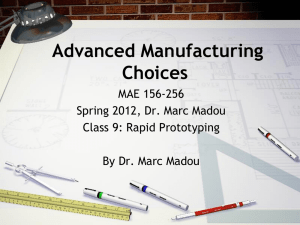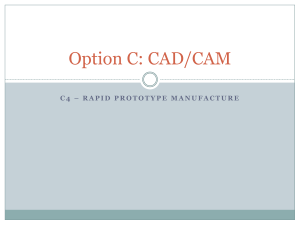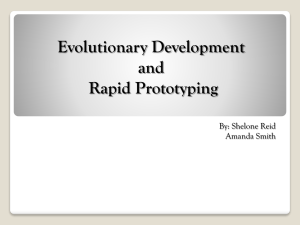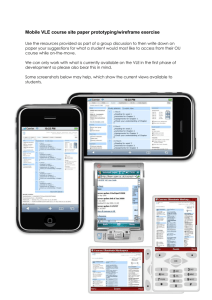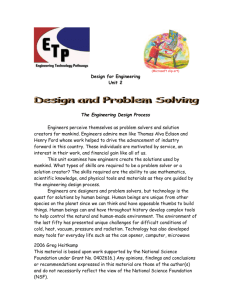Computer Integrated Manufacturing
advertisement
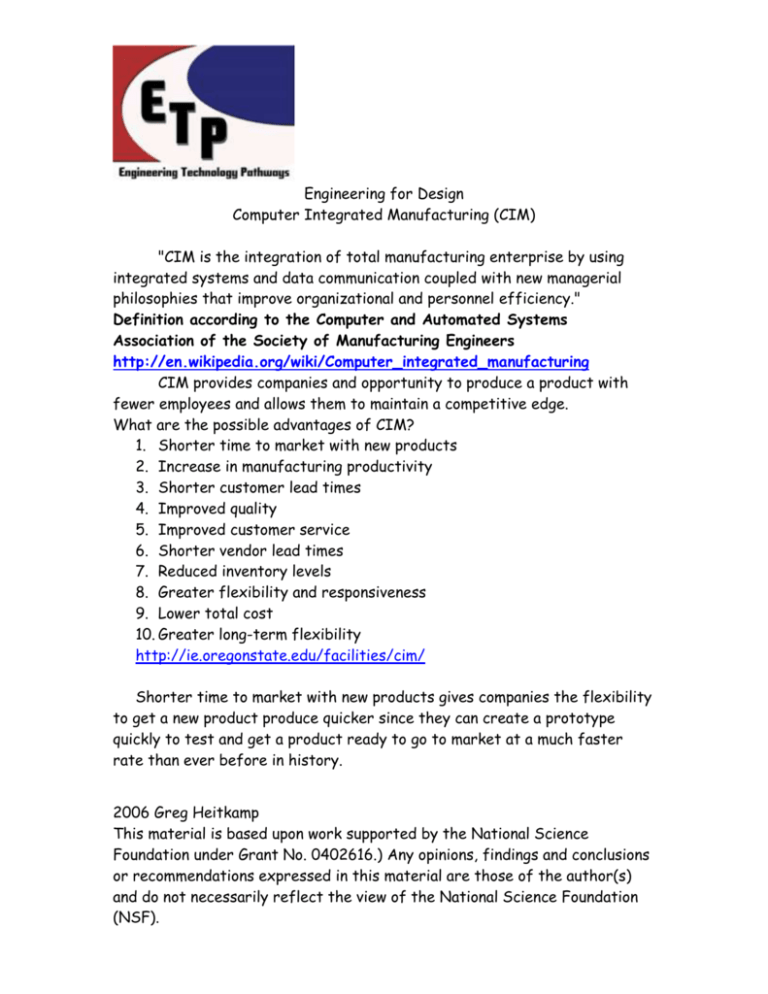
Engineering for Design Computer Integrated Manufacturing (CIM) "CIM is the integration of total manufacturing enterprise by using integrated systems and data communication coupled with new managerial philosophies that improve organizational and personnel efficiency." Definition according to the Computer and Automated Systems Association of the Society of Manufacturing Engineers http://en.wikipedia.org/wiki/Computer_integrated_manufacturing CIM provides companies and opportunity to produce a product with fewer employees and allows them to maintain a competitive edge. What are the possible advantages of CIM? 1. Shorter time to market with new products 2. Increase in manufacturing productivity 3. Shorter customer lead times 4. Improved quality 5. Improved customer service 6. Shorter vendor lead times 7. Reduced inventory levels 8. Greater flexibility and responsiveness 9. Lower total cost 10. Greater long-term flexibility http://ie.oregonstate.edu/facilities/cim/ Shorter time to market with new products gives companies the flexibility to get a new product produce quicker since they can create a prototype quickly to test and get a product ready to go to market at a much faster rate than ever before in history. 2006 Greg Heitkamp This material is based upon work supported by the National Science Foundation under Grant No. 0402616.) Any opinions, findings and conclusions or recommendations expressed in this material are those of the author(s) and do not necessarily reflect the view of the National Science Foundation (NSF). Increase in manufacturing productivity implies the ability allows companies to increase their product production at a higher rate and at a lower cost. This ability means higher profits and more money for more research to create more products. Shorter customer lead times provide the customer quicker access to product. Improved quality is attained since the integration of technology allows a more consistent and repeatable process to be used. The repeatability gives more consistency to the product along with higher quality since the product has a much more even level of product. Shorter vendor lead times allow a vendor to promote getting product to the consumer at a much faster pace than without CIM. Shorter vendor lead times give the consumer and the vendor a faster rate of return on their monetary investment thus leading to increases in profits. Reduced inventory amounts are required for the simple fact you can used the shorter lead times of the vendors to keep less product on hand and yet maintain their inventory. Greater flexibility and responsiveness provides the ability to companies to change product production lines very quickly and respond to customer needs almost immediately. This ability provides better control of product production and eliminates excesses of inventory. Lower total cost results from less manual labor being required and increased efficiency of the production and better quality control of the product. Greater long term flexibility results from being able to use the same system for more than one type of product and for more than one type of product. 2006 Greg Heitkamp This material is based upon work supported by the National Science Foundation under Grant No. 0402616.) Any opinions, findings and conclusions or recommendations expressed in this material are those of the author(s) and do not necessarily reflect the view of the National Science Foundation (NSF). CIM Rapid PrototypingTechniques One particular type of CIM Technique is known as Rapid Prototyping. Rapid Prototyping is often times a one step process to quickly produce a prototype of an object. The process is done using a drawing program such as AutoCAD, Solid Works or ProDeskTop and interfacing it with a rapid prototyping machine using an STL or SLA file format. Rapid prototyping takes the virtual design (from computer aided design (CAD) or from animation modeling software), transforms them into cross sections, still virtual, and then create each cross section in physical space, one after the next until the model is finished. It is a WYSIWYG (What You See Is What You Get) process where the virtual model, seen on the computer screen and the physical model, created in the rapid prototyping, correspond almost identically. http://en.wikipedia.org/wiki/Rapid_prototyping Stereolithography (SLA) is the first technique used, developed by 3D Systems of Valencia, California founded in 1986. The process involves a vat of photosensitive resin with a vertically moving platform, which a laser beam cutting with heat the material, moving downward on layer at a time at approximately .01 millimeter/.004 inches, tracing out the part, and partially curing the material. Parts some times need to be supported by other means to finish the cut. The model is the removed from the machine and the part is set aside to cure fully. Since the art is created with a layered process the part has a step appearance and must be sanded to create a smooth surface. The time to build and the size of the steps in the build is determination of the axis used for the cutting process using the long “y” axis on a vertical cut will give you minimal stapes but takes a longer build time to complete, while using the horizontal axis as the long “x” axis creates bigger steps but a much shorter build time. Your “z” axis can not be accurate since there is no step for it in the milling process. http://www.efunda.com/processes/rapid_prototyping/sla.cfm 2006 Greg Heitkamp This material is based upon work supported by the National Science Foundation under Grant No. 0402616.) Any opinions, findings and conclusions or recommendations expressed in this material are those of the author(s) and do not necessarily reflect the view of the National Science Foundation (NSF). http://www.efunda.com/processes/rapid_prototyping/sla.cfm A diagram of the SLA process showing the main components above and below a picture of some models created with SLA. http://www.stereolithography.com/stereolithography_images.php Selective Laser Sintering Selective Laser Sintering is a process patented by Carl Deckard, a University of Texas graduate student in 1989. The major advantage over SLA revolves around the properties of the materials that can be used in the process. Many different materials are possible to use and exhibit the 2006 Greg Heitkamp This material is based upon work supported by the National Science Foundation under Grant No. 0402616.) Any opinions, findings and conclusions or recommendations expressed in this material are those of the author(s) and do not necessarily reflect the view of the National Science Foundation (NSF). properties of thermoplastics such as polycarbonate, nylon, or glass-filled nylon. Diagram of how things work from http://www.efunda.com/processes/rapid_prototyping/sls.cfm http://www.efunda.com/processes/rapid_prototyping/sls.cfm SLS prototypes are easier to machine and less prone to the stress caused by the process of laying and curing. SLS arts are easier to cast sections together and are supported by the excess powder of the process. www.toolcraft.co.uk/helpslsproc.htm 2006 Greg Heitkamp This material is based upon work supported by the National Science Foundation under Grant No. 0402616.) Any opinions, findings and conclusions or recommendations expressed in this material are those of the author(s) and do not necessarily reflect the view of the National Science Foundation (NSF). Laminated Object Manufacturing In the laminated object manufacturing (LOM) process paper sheets of material with an adhesive on one side are heated onto a substrate material. A laser then traces the pattern of the object on the material. The areas that are not part of the object are crosshatched cut for easier removal. Upon completion of this step the material moves down and another layer of material is added and the process continues until completion of the object. A drawing of the device from http://www.efunda.com/processes/rapid_prototyping/lom.cfm http://www.efunda.com/processes/rapid_prototyping/sls.cfm 2006 Greg Heitkamp This material is based upon work supported by the National Science Foundation under Grant No. 0402616.) Any opinions, findings and conclusions or recommendations expressed in this material are those of the author(s) and do not necessarily reflect the view of the National Science Foundation (NSF). Using this process produces a product with a wood-like texture. This product has to be sealed to prevent moisture causing problems for the model. If moisture is absorbed it may cause expansion of the materials and instability in the model. Painting and lacquer are used to seal the product to prevent such damage. New materials with metal and plastic have developed by the process developer to improve the product. It is now possible to a powdered metal and make a “green” or not cure product that can be heat cured or sintered to create the final product. The process has the availability of low cost material and can be used to create relatively large models because of chemical reaction. It has a lower “z” axis capability and needs no milling process in prototype development. This process is much less prevalent that SLA or SLS processes. Picture of a laminated object manufacturing process object. http://www.moma.org/exhibitions/1995/mutantmaterials/fibers.html Fused Deposition Modeling Fused Deposition Modeling (FDM) is a process that involves heating a filament of a thermoplastic polymer and squeezing it out, much like you would toothpaste, from a tube to form Rapid Prototype layers. This process was developed by Scott Crump in 1988 and the machines are manufactured by Stratasys of Eden Prairie. The machines range from fast concept machine to slow high precision machines. Standard ABS plastics can be used for models and two different materials can be used in one process. The thermoplastic cools much more quickly because the platform is at a much cooler 2006 Greg Heitkamp This material is based upon work supported by the National Science Foundation under Grant No. 0402616.) Any opinions, findings and conclusions or recommendations expressed in this material are those of the author(s) and do not necessarily reflect the view of the National Science Foundation (NSF). temperature. This type of rapid prototyping is not as common, but is gaining popularity since it use desirable materials. Here is a diagram of what the process looks like. http://www.efunda.com/processes/rapid_prototyping/sls.cfm http://www.efunda.com/processes/rapid_prototyping/fdm.cfm Picture of a fused deposition object. http://bjr.birjournals.org/cgi/content/full/77/918/504 2006 Greg Heitkamp This material is based upon work supported by the National Science Foundation under Grant No. 0402616.) Any opinions, findings and conclusions or recommendations expressed in this material are those of the author(s) and do not necessarily reflect the view of the National Science Foundation (NSF). Standards Addressed Standard 2: Students will develop an understanding of the core concepts of technology. AA. Requirements involve the identification of the criteria and constraints of a product or system and the determination of how they affect the final design and the development. BB. Optimization is an ongoing process or methodology of designing or making a product and is independent on criteria. Standard 10: Students will develop an understanding of troubleshooting, research and development, invention and innovation, and experimentation in problem solving I. Research and development is a specific problem-solving approach that is used intensively in business and industry to prepare devices and systems for the marketplace. J. Technological problems must be researched before they can be solved. 2006 Greg Heitkamp This material is based upon work supported by the National Science Foundation under Grant No. 0402616.) Any opinions, findings and conclusions or recommendations expressed in this material are those of the author(s) and do not necessarily reflect the view of the National Science Foundation (NSF).

